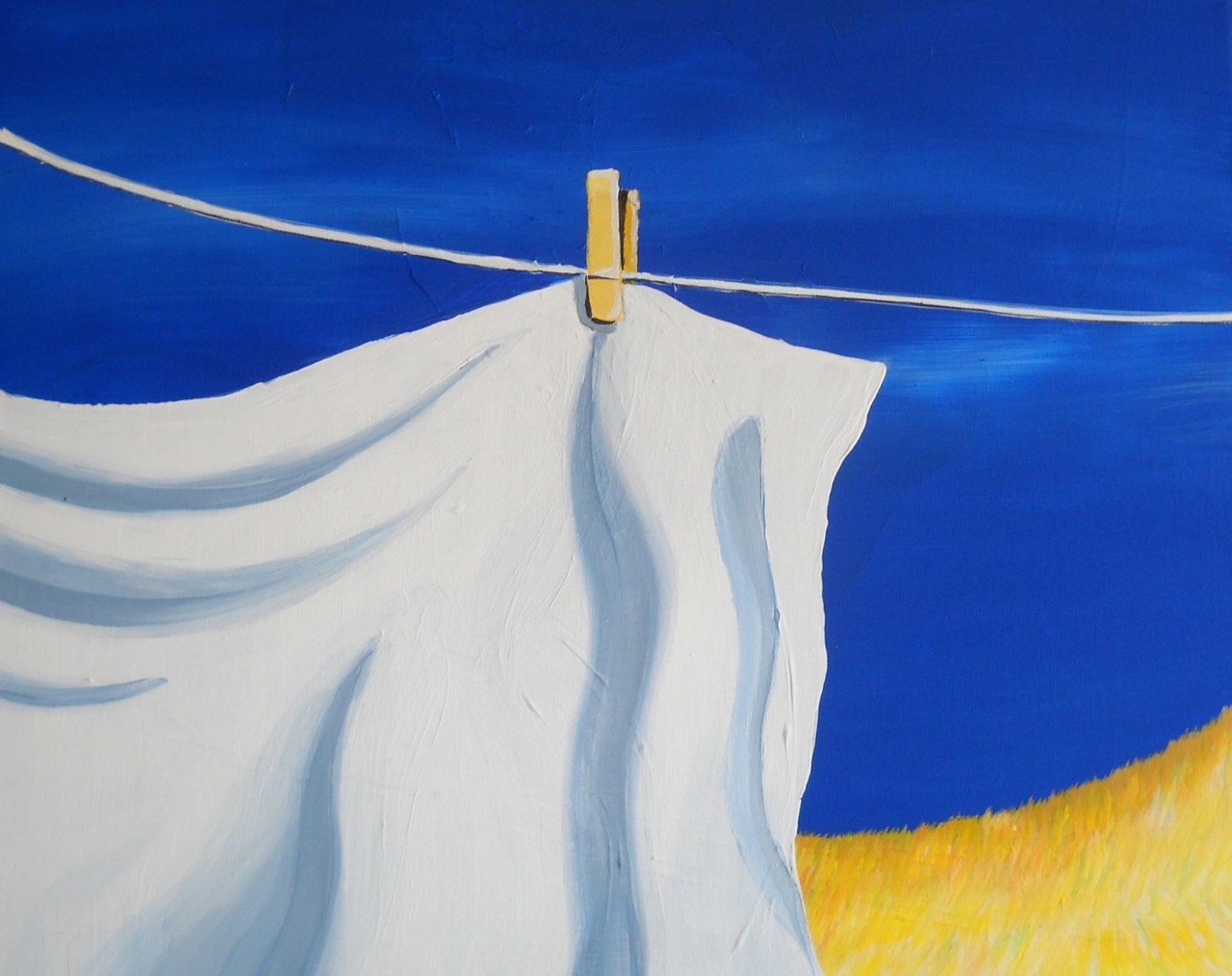
© Copyright 2003, 2012, Windhook®
All rights reserved. |
Skip the chatter & sign me up! |
|

"Great interview! Great guy! Thanks for bringing Jason Kelly into the limelight. I enjoyed all the article and have passed it along to several friends. Well done!" —Lynn |
This month in Outside the linesHere's a sneak peek at what's inside for January. From the January 29 installment: Rejected!Let's talk for a minute about juried shows. Juried shows are one of the most perplexing and emotionally charged phenomena of the art world. We are involved in putting on a juried show right now for the Phantom Project, and today was intake day. This is one of those shows where everyone brings in their art in the morning and goes away for the lunch hour. The jurors make their choices, then everyone returns in the afternoon to see whether they made it into the show. 
While this kind of show is very fast and efficient to jury, it is also the most traumatic for artists. If at least one of your pieces is accepted, you're spared the worst of the trauma. But if not, then your entire ego is laid bare, and you have to do what one artist at today's intake and jurying event good-naturedly called "the walk of shame." You can't just slink away to nurse your wounded ego, you have to pick up your work and walk it out the door for all to see.
The reaction of artists to this experience is as diverse as the artists to whom it happens. Some are devastated and find it difficult even to speak. Some shrug it off with little difficulty. Some are openly angry. Some are dignified and gracious. Some joke lightly. But no matter how good natured you are, no one likes being passed over by a juror. Show curators often find euphemistic ways to refer to this, but to the artist it happens to, it always feels like rejection. It always tugs at your center and calls into question the very reason for your existence as an artist. And it's also the most ubiquitous experience that visual artists share. If you have not been juried out of a show, then you haven't entered enough shows. And if you are thin skinned about being juried out, you are pretty normal. Artists pour their soul into their work in ways that few other professions do. So it's tough to stand up and be civilized when somebody nonchalantly smacks down the expression of your deepest core.
Add to this, the pure subjectivity of jurying art. Any three jurors will select different work for a show than any other three jurors. And often, the same juror will select different work on two different days. From the outside, the process might seem fickle and unfair. It might actually be fickle and unfair. Jurors are chosen for a show based on their expertise and experience in the art world. But the art world is purely subjective, as are the art, the artists, the jurors, the curators, the buyers, and the critics who contribute to this world. And yet we all respond to the reactions of a juror, a curator, or a critic, as if they had some final, authoritative, and objective dispensation on the merit of our work, our life, and our very soul. This reaction is absurd, of course, but almost inevitable. At today's event, I saw frustration and disappointment on the faces of some very good artists over some very good art that was passed by. Some of these same artists have made it into some very good juried shows recently, and some of those selected today have been passed by recently as well. One of those artists just finished a solo show at one of the biggest, most important venues in the region just last week. She did not get in today. I write about this to make a very important point. Rejection is the price of admission into this world of the full time artist. You will experience it. If you've been at it for long, you know this. If you've been at it for long, you've learned to steel yourself from it when it comes. If you have not experienced this sort of rejection, you have not entered enough juried shows. If your anger and frustration gets the best of you when the jurors pass over the work you have poured your heart and soul into, only to select an "obvious piece of crap" (and if you are for real as a working artist, they will eventually) then you are not entering enough juried shows. It's normal to feel anger, frustration, and self doubt at such times. Feel the feelings, but then get up and go again. Enter more juried shows! The art world expects it from you, and you cannot short cut your way around it. Paying your dues with juried shows is the venerable path in the art world. And it wouldn't be dues-paying if it always went your way. But you are the ultimate juror of your art. You have spent your self making your art. You have nourished your soul with making your art. A juror, by the necessity of the impossible task we assign to them spends seconds deciding to bless or ignore it. But jurors are here today, gone tomorrow. You are not. Stay the course. Keep getting up. Keep coming back. You will make your way. A note about this installmentThe article above was included in our Outside the lines member's note from January 29. This installment also includes the regular feature, Peggy's Progress. To get all the content we send to our members, you can subscribe here. The Phantom!—Part TwoA month ago, we told you about the Phantom Project, a local art project that we are involved in. You can read The Phantom!—Part One here. Since we wrote part one in mid-December, the Phantom Project has continued planning and publicity work for the show. We have used our Facebook presence, along with the usual communications channels of our local artists' groups, the San Luis Obispo Museum of Art(SLOMA), and several other local art organizations including Arts Obispo (the official sponsor of Art After Dark) and the Paso Robles Art Association to keep the show in front of our local art community. The buzz has begun and everyone we talk to now knows about the show. The fact that we are taking applications and taking in art only a week before the opening means that we have no clear idea how big the response will be until the artists show up at the door on intake day. But every indication is that we will get a good response. We have designed a logo with a street art stencil motif in keeping with the guerilla mentality of the Phantom Project, and are cutting stencils to paint it on the windows and a wall of the gallery space. We designed it so it would work on future events as well, and we are looking into getting logo tee-shirts made to sell at the show. As I said last month, we started out with 6 members of the phantom project team. Since that time we have had several others step in, sensing the energy that's building around the project. We expected this, and welcome any latecomers that want to get on board. Each member of the team has a sense of being involved in something that has legs beyond just putting on a single art show. We are calling it "the Phantom Project" rather than "the Phantom Gallery" or "the Phantom Show" for a very specific reason. We expect to do more. At this point the project is putting on a show in vacant retail. That was our original idea. But we might do other things that are spontaneous and innovative, and we want our brand to be flexible enough to embrace new ideas. We are beginning to think about what could be down the line after this show. 
There is a local twice monthly radio show called Ears on Art produced by Steven deLuque, a local artist, jeweler, and one of our jurors, and Crissa Hewett, a local artist, widely acclaimed silversmith, and president of the Central Coast Crafters group affiliated with SLOMA. They are providing us with public service announcements of the show. We wanted an interview, but could not break into their schedule on such short notice. So we are planning to do an interview in the aftermath of the show instead. This actually works out better, because we can tell the story of the show, and prime the pump for the next event. This is a wonderful example of the kind of publicity that serves not only the project, but the creative minds who conceived and executed it successfully. Are you beginning to see how a project of this kind can propel your own professional standing in your creative community? And that's how we began the January 22 installment. Subscribers can view it in its entirety here. Editor's noteFrom time to time, we will offer a complete installment of Outside the lines to our free list and blog followers as a thank you for your interest. On the morning of January 15 we did just that. We've copied it here and hope you enjoy it, and if you've been planning to sign up for the full subscription and just haven't gotten around to it, here's your chance. It's just a couple of clicks away, and will get you on board for all of our best stuff. A Place to Work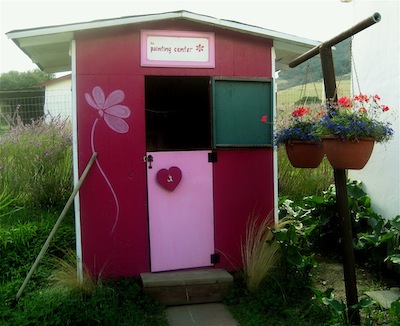
Whether you are a sculptor, a writer, a musician, a yoga teacher, a painter, or a custom fly tyer, you need a place to work. The requirements for your work environment are very personal and unique, in part because of who you are, and in part because of what you do. The tools of your craft are a key factor in the choice of a work space. Do you use 3-phase power and multi-ton machines? Do you need a sweeping view, or filtered light from the north? Do you wear hearing protection when you work? Do you need quiet and tranquility? Do you need a large open floor to work out your choreography, or can you curl up in an overstuffed chair with your laptop and earbuds in a quiet corner of a local coffee bar with dim light and soft conversation as a backdrop? Does everything need to be in its proper place or are you more comfortable in that curious organizational space that looks like absolute chaos to an outsider, even though you know exactly where everything is? Do you collaborate with others in your work or do you work in solitude?People who make the choice to live and work according to their own creative calling rather than in the job market do not always have the luxury of setting up their ideal work environment from the start. Spare rooms, tool sheds, patios, garages, and kitchen tables are standard work environments for many of us. And sometimes these re-purposed spaces are just fine. But it's important to understand what the impact of your work environment is on your creativity and proficiency. Too many distractions, too much set-up and take-down between sessions, too many conflicting requirements on your space can all drain vital energy from your work. If you are in such a shared or borrowed space, take some time to evaluate what the conflicts are and assess ways to minimize them. 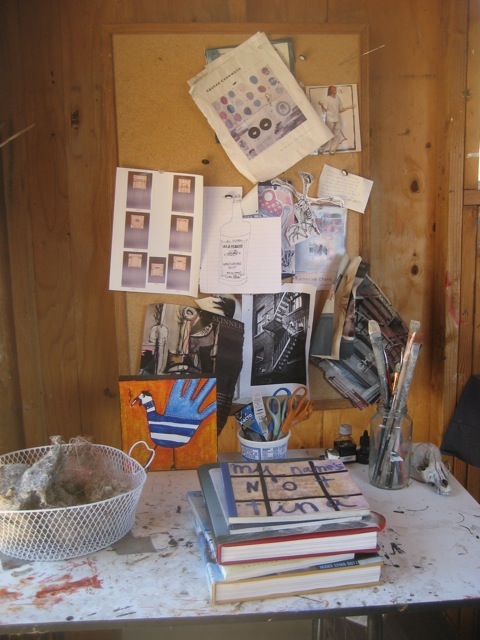
If you have the luxury, and by this we usually mean if you have the money, to design and set up your ideal work environment, it's important to take stock of what you need before you begin. Yes, you need space for the tools of your craft, and you need a well designed work area. These are specific to your craft, and we cannot address your detailed technical requirements here. But regardless of your craft, you need the right kind of emotional energy in your work environment. In addition to working out the work flow and storage and equipment issues, get a feel for the feel of the space. Optimize the layout to take advantage of whatever environmental factors can work for you in the space. Do you have sweeping views? If so, be sure to capture them in the orientation of your work space. Be sure your design incorporates a music system if this is important to you. Think about the impact that heat and cold will have on your comfort and ability to immerse yourself in the work. But almost more important than any of these logistical and tactical aspects of your work environment, there's a profound psychological value in something we call sacred space. In her interview a couple of weeks ago, Amy McKay talked about this.
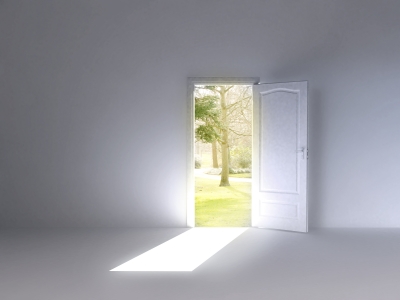
Amy has created something very important for the creative process. She has set her work space and process apart from the ordinary everyday world. Her family knows this and she protects it. This sense of the sacred space where creativity lives is extremely valuable. It's most easily accomplished in a full time dedicated location, But you can make it happen in shared or part-time space as well. There are three elements to this notion of sacred space: the space itself, your actions in preparation, and the physical elements incorporated into your process. Perhaps there is a special box that you keep your supplies and equipment in. Perhaps there is a process or ritual you engage to prepare yourself to work. The important thing is that you find a way to make a special creative space, physically, symbolically, and psychologically, around your work time. Amy said one other thing that we want to touch on here. "I decided that if this is what I wanted to do, if I wanted to be a full-time artist, that I had to act like I already was. If this was my only job, and I had already made it, already got the exposure and validation and all that, what would I be doing? And part of it was telling people I was an artist, which was hard to say at first. You know I'd meet people and in chit chat, they would ask what I do. I started forcing myself to first say I'm an artist..." This statement is one of the strongest arguments for defining, developing, and defending your work space against the onslaught of everyday life. When you take measures to make your own creative sanctuary, in whatever form, and with whatever components are important and effective for you, you are sending a clear message to yourself and to the world around you. "This is real. This is my work. This is my job." It helps you to overcome that nagging uncertainty that haunts so many who dare to step outside the lines. 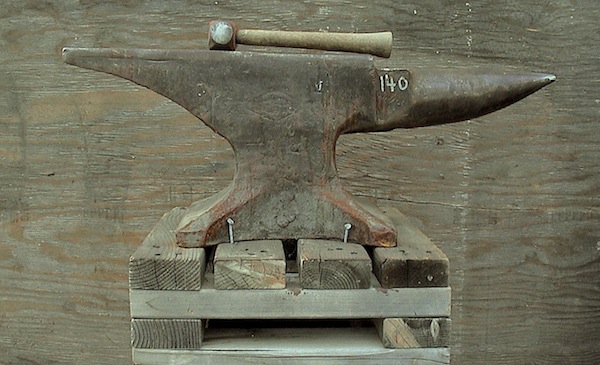
The Fear of Being Ordinary
The following is lifted from our January 8 installment.
You can see the rest of this installment here. The Windhook Interview—Amy McKay Amy McKay was on a traditional career path in landscape architecture until the economy threw her, and the entire construction and architectural design industry a curve beginning in 2008. She followed that curve right into her life's passion and is now painting in her own studio space and showing and selling regionally. Her story is about closed doors. Her story is about opening your own doors. The choices Amy is making add up to a remarkable example for artists trying to find their way in this tough economy.
Amy McKay was on a traditional career path in landscape architecture until the economy threw her, and the entire construction and architectural design industry a curve beginning in 2008. She followed that curve right into her life's passion and is now painting in her own studio space and showing and selling regionally. Her story is about closed doors. Her story is about opening your own doors. The choices Amy is making add up to a remarkable example for artists trying to find their way in this tough economy.
Amy paints and shows in San Luis Obispo, California where she lives with her husband, Lief, and their two young children. Excerpted from the January 1 interview.
We have extracted a couple of interesting passages from Amy's interview to share with you here. We begin at the start of the interiew, with the chain of events that propelled Amy from artchitecture into art.
Michael: So how long have you been doing art? Is this one of those things where you grew up knowing you were going to do it?
Amy: Yeah, and then when it was time to go to school I want to say I chickened out. I was too scared—you know, lack of confidence. There would be a lot of people better than me. What if I couldn't get a job. Or I just wasn't good enough. So I just went to community college for a few years and then I found landscape architecture and that combination of creativity and creating outdoor spaces really appealed to me because I grew up camping and hiking. Peggy: Where did you grow up?
Amy: In Auburn, California. So the Sierras were kind of my backyard. I painted on and off over the years but never very consistently. You can make all kinds of excuses—you're too busy. And then you have kids. And I was too busy before that. And then a few years later, when people at RRM was dropping like flies, It occurred to me that I could be next. There's no other work in landscape architecture around here at the moment and I thought I'd better figure out what I would do instead. And if I had to do it over again, painting is what I'd always come back to.
So I just started talking to people about this idea of having a studio and making a go of it. I could either wait until I'm retired and my kids are grown up and do it then, or by that stage I could look back and be glad I'd been painting for the last thirty years and also be an example to my kids that this is a passion and I went for it and just somehow made it happen. So it was amazing when this studio actually came to fruition—these four walls.
Michael: You've sort of touched on this in your reference to RRM, but this economy seems like it's had a real profound effect on a lot of people and specifically increased people's willingness to take that chance. How much of an impact on your decision process was the precariousness of having a "real job"?
Amy: I don't think my studio would exist if the recession hadn't happened. Because I would have just been working along and everything would have been like planned and it would have still been out there in the future some day. But if I'm hardly working, what do I have to lose?
Michael: So were you part-time at RRM?
Amy: Yes.
They had the option to cut back my hours without letting me go. They laid off people and then they went to this "call-off" so my regular hours were three days a week. Every Friday I would check the schedule and if they had the work I would come in, and sometimes they didn't, so that day would be a call off. There were some weeks when there was nothing. I could sit around at home feeling really stressed and really down about this or I could make the most of my time. It was one of those turning points where I just decided that it's worth the risk.
My kids were usually at school. Maggie just started kindergarten, but before that she was at pre-school. I couldn't just keep her home for a week to save money because she would lose the spot. That was hard because I wasn't working, and financially it was a stretch. But at the same time I needed to keep her there, so I suddenly had time by myself at home, which is rare. So whenever I had call offs I just looked at it from a positive perspective—great, I'm going to be in the studio, and I've got a plan. Michael: So tell us about the studio and how it came about? Amy: My friend Shelly who lives just over the field. She really inspired me to just do it. We went to Home Depot and looked at those sheds out front to see what was possible for what kind of money. And then I looked at Don Seawater's place, Pacific Coast Lumber. I looked at his little sheds, and it was a little bit more than I could afford because they build it off site and bring it in. But I didn't like the sheds at Home Depot so... I looked to my friend, Bill Isaman, who's an architect, and asked him to give me his best costs, material wise—what would this cost to build? His estimate was less than what the Home Depot sheds cost, but obviously that didn't include any labor. But we didn't pay for labor. Little by little as we talked to people, someone would say, "well I can help you with this," or "my husband is a contractor and he has a couple windows sitting in the garage." And little by little it just came together. Peggy: Had you ever built anything before? Amy: No. We set a date for something like a barn raising weekend and a couple of weeks before that we dug out the foundation. We built it on 6 x 12 pressure treated beams. That's a great foundation for a little building like this. Amy: We looked at doing concrete. But because we don't own the property, the landlord didn't want a permanent structure. So the beams were down and the floor joists were down and all the material had been delivered. And then we had Saturday and Sunday with 8 guys—friends, and my uncle came from Eugene. They all had some building experience and one friend is a contractor locally. So he was a huge help. By lunchtime that first day it was totally framed out. Michael: Very early on in this process of making the transition, you settled on having a separate, well defined studio space apart from your living space. Some people try to do it in their garage or spare room or living room. Amy: Oh yeah, it's my woman cave and all my friends are jealous. I've painted in the living room and we have 900 square feet so that isn't very effective. I mean the family was tolerant of it and I tried to clean up and move it to the side a little when I was done but I still never painted very effectively unless Lief and the kids were gone. Something happens from the back door to the door of the studio. On that walk, it doesn't matter what's going on in the house or what kind of day I've had or if the house is a disaster and there's a bunch of chores to be done. I leave all that behind. Next, we look at Amy's advice to budding artists who are just starting out. We had been talking about the issue of self confidence earlier.
Amy: Let's go back to something you said earlier. This might be a good response to what advice I'd give to other artists. I decided that if this is what I wanted to do, if I wanted to be a full-time artist, that I had to act like I already was. If this was my only job, and I had already made it, already got the exposure and validation and all that, what would I be doing? And part of it was telling people I was an artist, which was hard to say at first. You know I'd meet people and in chit chat, they would ask what I do. I started forcing myself to first say I'm an artist and then a designer and I work at RRM as well. That was really hard. I felt like I was faking it.
Peggy: The impostor.
Amy: Like someone would call me out. But it's also a self marketing thing too. There are parents I see everyday at school at pick up who don't know what I do because I don't talk about it. And then someone will find out because I can't go wine tasting with the ladies because I'm painting. Painting? Tell me more. What?
So that's been part of it, just pretending that I'm already there. And it really makes a huge difference. Working regularly is important too. I was just telling Lief the other day that when I'm producing here it's like that energy goes out into the world and then I'm selling. And then when there's a break of time when we're busy with family or whatever and I'm not out here, nothing happens. I don't just get a random call that somebody wants something. But I did a little show with these panels. I had 12 of them and I was making jewelry and during that month I got a call out of the blue to do a commission and then another. There were two commissions and a couple other things fell into my lap at the same time. So I just feel like if I keep working then I keep selling. But for some reason when I'm not actively pursuing it, nothing happens. So that would be my advice - just pretend you're already a full time artist and you've already made it and you've already got people who want your work and you just need to produce.
|

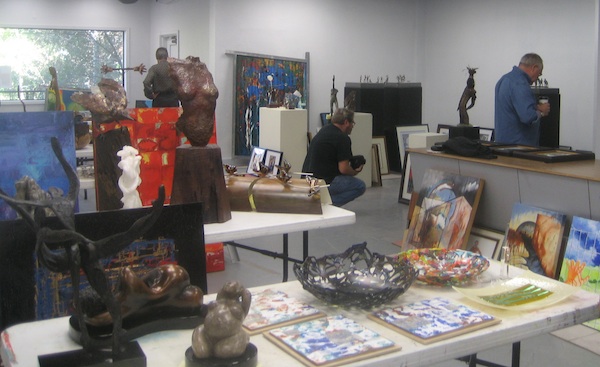
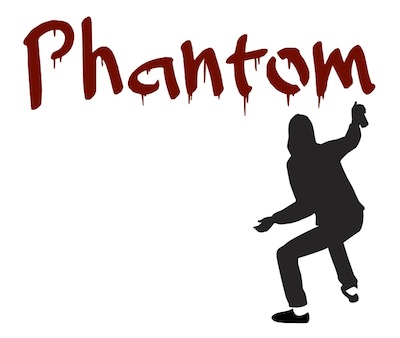 This in spite of the fact that the concept for the show had not even seen the light of day three months ago. Art shows typically have a longer lead time than this to make it easier to get publicity, to get on the schedule of the gallery, and to give the artists time to prepare new work. Because we are using vacant retail space, and not requiring the artists to present new work in this show, we have overcome two of the three reasons that a show usually cannot happen this fast. And we are using the internet and our own enthusiastic energy to get the word out quickly.
This in spite of the fact that the concept for the show had not even seen the light of day three months ago. Art shows typically have a longer lead time than this to make it easier to get publicity, to get on the schedule of the gallery, and to give the artists time to prepare new work. Because we are using vacant retail space, and not requiring the artists to present new work in this show, we have overcome two of the three reasons that a show usually cannot happen this fast. And we are using the internet and our own enthusiastic energy to get the word out quickly.

